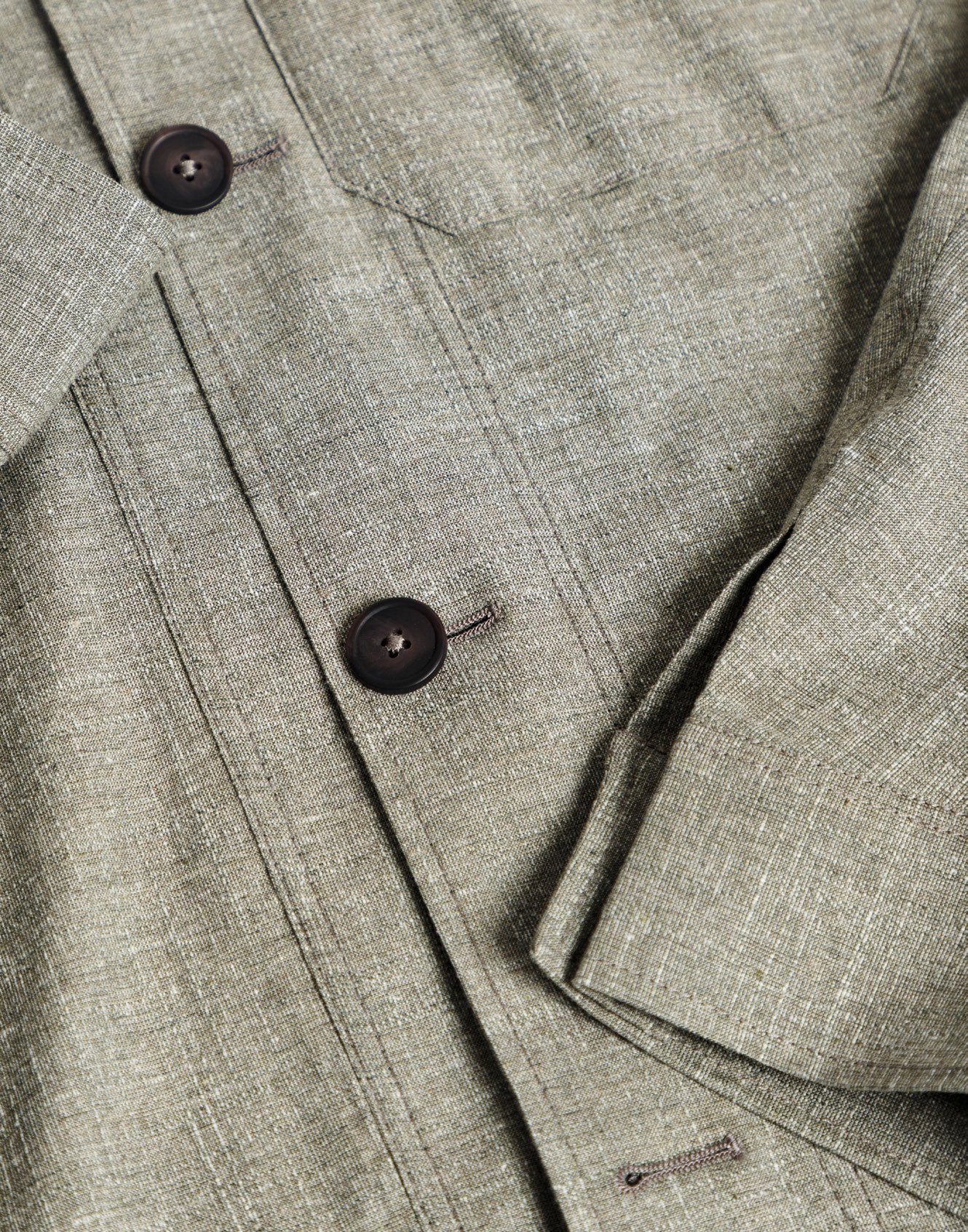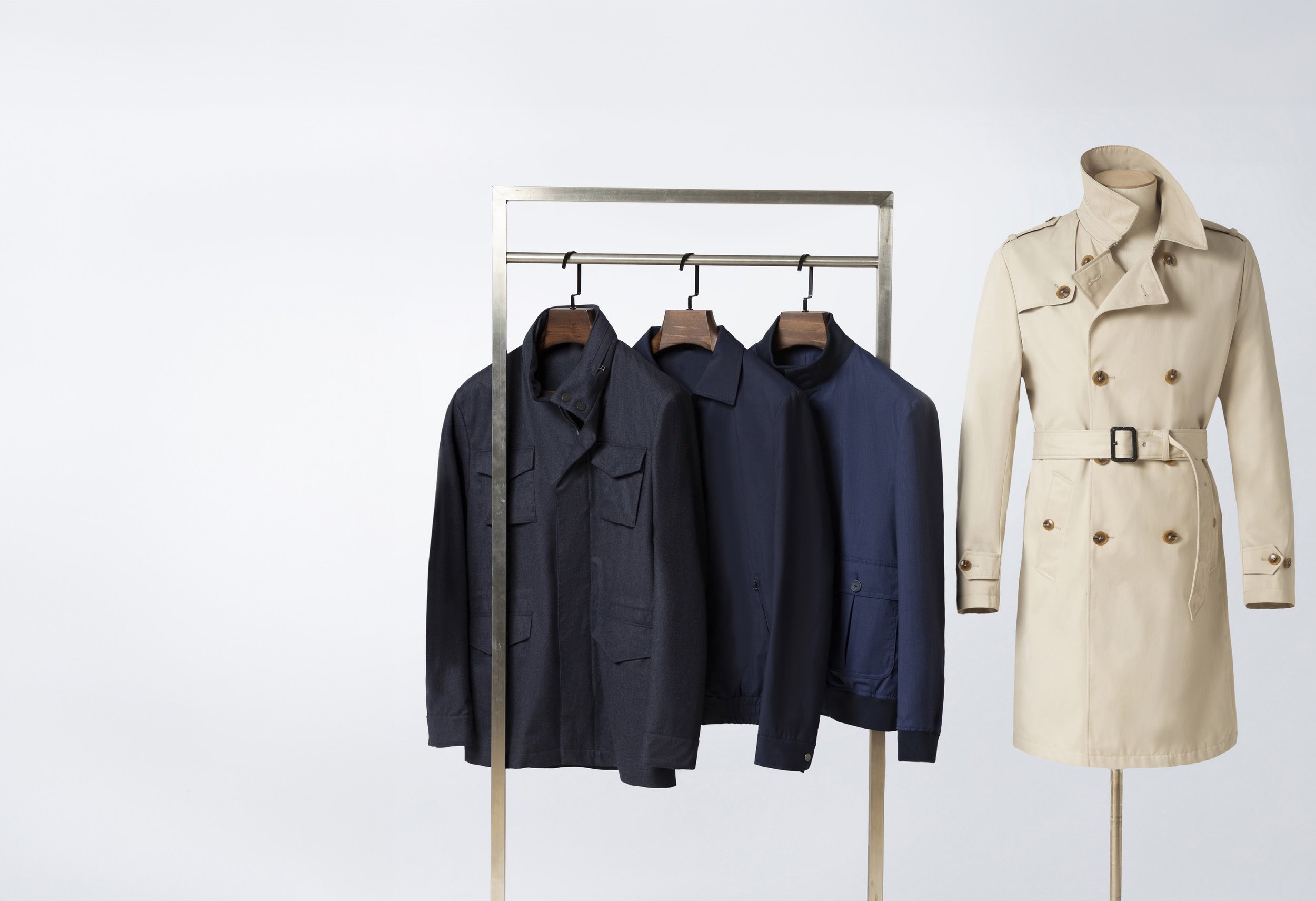MADE-TO-MEASURE OUTERWeAR
COLLECTION

Raincoats : When Form follows Function
Rainwear occupies an essential place in the male wardrobe, providing both protection and style. As is often the case with men’s clothing, their origins are primarily military, but their adoption by civilian fashion has allowed these iconic pieces to evolve to meet the needs of each era.
Beyond their role in protecting against the elements, these garments today occupy a prominent place for spring and autumn, and have become a means of affirming a sartorial heritage while stepping out of strictly formal styles. In this regard, shorter jackets play a role comparable to that of a parka, car coat, or trench coat, prompting us to group them within the same product family.
The Trench coat
The trench coat is undoubtedly one of the most iconic pieces in men’s fashion, and the most iconic raincoat.
Originally designed for British officers during World War I, it was crafted from waterproof gabardine and featured a long cut with functional details like epaulettes and an adjustable belt.
It also included a shoulder flap, usually on one side, to prevent rain from flowing inside the trench coat when the soldier aimed their rifle.
Its length, the refinement of its belt, and the way the shoulder and collar details flatter its wearer have made it a preferred piece for both men and women, with tailors and luxury houses continuously updating it.
We honor the heritage of the trench coat as popularized by the finest brands. The model we offer retains all the classic characteristics, which in our eyes, represent the essence of the piece: double-breasted fastening, belt, topstitched collar to be worn up, slanted pockets, adjustable cuffs, and the shoulder flap, a true signature of the piece.
The car coat
The history and evolution of the car coat are closely linked to the development of the automobile.
Before it became a raincoat for city use, the car coat was designed to protect drivers of early cars, which had open designs that fully exposed them to the elements and dust. It subsequently underwent numerous variations in length and design, drawing inspiration over the decades from various military styles and other types of rainwear.
In our view, the essence of the car coat is defined by a few key features: a straight-cut, mid-thigh raincoat with a generous shirt collar, topstitched for an upright fit.
These characteristics are found in the two versions we offer: a classic version, with visible or hidden buttons, featuring sleeve tightening tabs, and a modern version with a zip closure, featuring a simpler, cleaner cuff. Compared to the trench coat, which stands out for its distinctive character, the car coat fulfills the role of a classic, yet understated and discreet raincoat.
Customization is achieved through the choice of closure (including a snap button option) and pockets, featuring the recurring options from our raincoat collection.
The Rib Bomber
The RIB Bomber product family includes several iconic ribbed jacket models: the A-1 and its A-2 variant, and the Teddy, each with a rich history and distinctive details.
Introduced in the 1920s, the A-1 is one of the first Flight Jacket models adopted by the U.S. Army. Initially designed for pilots in thick leather, the A-1 jacket features generous buttoned flap pockets and ribbed elastic collar, cuffs, and bottom for optimal comfort and insulation against the cold.
Its sport-chic look, glorified by icons of Hollywood’s golden age, quickly made it a symbol of masculine style.
We also offer an alternative version with slanted zippered pockets, known as the A-2.
The Teddy Bomber
This model is inspired by the zippered ribbed jackets known as Varsity Jackets or Letterman Jackets, commonly worn on American university campuses.
In France, these models became known as Teddy due to the Teddy Boys stylistic movement during the 50s and 60s, a British subculture that eventually incorporated elements of American Rock style as it spread to Europe.
Its more streamlined style compared to the A-1 has made it the main inspiration for many modern ribbed jackets, familiarly grouped under the term Bombers, even though they are now quite far removed from the original bomber jackets of the era in quilted nylon or sheepskin.
The Blouson
The history of zippered jackets is complex, blending military influences with those from auto and motorcycle racing. The models freely borrowed details from each other, eventually creating a plethora of variations, the genesis of which could fill entire books dedicated to the subject.
We believe there is a common vision of the modern jacket, characterized primarily by a zip closure and an elastic bottom made from the main fabric, which distinguishes it from the RIB models whose ribbing gives a decidedly more vintage look.
This base then branches into multiple pocket styles and, most importantly, collar styles, whose choice influences the overall style of the jacket more than any other detail.
The Country jacket
Our Country Jacket is inspired by iconic gentleman farmer style country jackets, typically made from gabardine, waxed cotton, or tweed.
Made from smooth, contemporary raincoat fabric, its rustic origins are more discreet, giving it a sport-chic appearance with a press-stud collar flap, rear tightening tabs, and four generous pockets.
Contrasting collar and cuff finishes in corduroy are optional, reaffirming its rural heritage.
The Field jacket
Our Field Jacket is inspired by military jackets used by the U.S. Army during World War II and the Vietnam War, particularly the iconic M-65. Designed for maximum versatility and functionality, it was intended to be shorter and lighter than previous parka models, adapting to deployments in hot and temperate climates.
It featured multiple strategically placed pockets for storing military equipment and an internal drawstring to adjust the silhouette, retain heat, or facilitate air circulation.
During the Vietnam War, these jackets kept by veterans and widely distributed as military surplus became true style icons, even symbols of protest in the hippie and rock movements, subverting the martial origins of the piece.
Available in two versions with different pocket styles and arrangements, our interpretation of the Field Jacket retains its utilitarian essence while incorporating contemporary finishes. The most notable detail is its stand-up collar, which conceals an interior hood with waterproof lining, accessible via a hidden zip, offering both practicality and visual refinement.
The parka
The word parka originates from the Arctic Inuit communities, meaning “animal skin” in the Nenets language. Traditionally, it was made from caribou or seal skins, often coated with fish oil for waterproofing.
Recognizing its intrinsic weather protection qualities, the U.S. Army drew inspiration from the parka in the 1950s to develop various models using modern materials, such as the N-3B Snorkel, designed for aircrews operating in extremely low temperatures, and the iconic M-51 Fishtail, whose drawstring hood and slanted flap pockets were quickly adopted by civilians.
The parka was notably popularized in the 60s by the British “Mods” movement, whose aesthetic mixed traditional British tailoring with sports, military, and workwear influences.
Our interpretation of the parka is simple and streamlined, designed to be worn with both relaxed tailoring and jeans, while staying true to its functional and protective roots.
A wide choice of pocket designs and closures allows for style customization. Additionally, it can be configured with a removable hood attached by a snap button system.



























